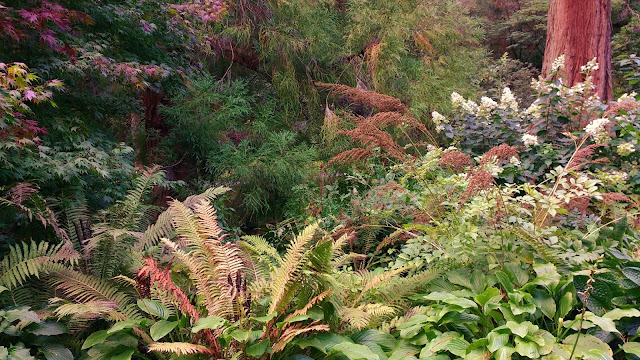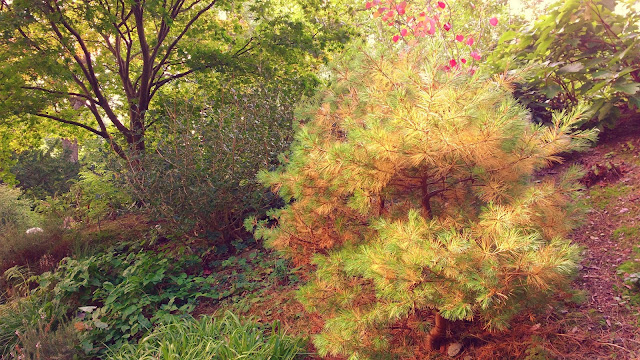Had we come to the Ring of Kerry to gaze upon the Skellig Isles and nothing else, it would have been a worthy trip. However, Michelle had arranged for us to stay at Kells Bay House & Gardens, known as the 'Jewel of the Ring'. Considering the Ring in question, an unending circle of wonder, one could fairly presume such a bold claim might open the walled garden's gates to disappointment. As grey rainclouds gathered, doubts loomed higher.
In the end, the clouds could have blackened and the evening drawn in swifter, and still these thoughts would have been dispelled by the enchantment of a garden the like of which I have never seen before nor shall likely see again. What an extraordinary place!
It began by stepping into the Ladies Walled Garden - perhaps so-named because it is the only part of the gardens with such hallmarks of civilisation as stone paving or roofed benches. Its centre point is a broken tree trunk, thick and ancient-looking, adorned with nature's palette of lichen. Surrounded by trees and shrubs, as we were approaching it in autumn it loomed before us out of a rough circle of red, purple and green foliage - a circle met by further pathways leading higher or lower, past walls or toward mossy stairways and out of sight.
One path lead out to something signposted the 'Primaeval Forest'. This lay outside of the stone walls, and yet if one were observing from a bird's eye view they could see that, in actuality, this meant stepping into a larger, more ancient and organic "walled" garden. Hills completely surround Kells Bay, each with fabulous names like
Cooduff or
Teermoyle, and combined with a thick forest canopy overhead they ensure the gardens never fall below five degrees centigrade in temperature. It is because of this natural alignment (and perhaps a little Victorian forestation), in such a remote pocket of Ireland, that something astounding has been borne.
As we discovered on our walk, the sign for a 'Primaeval Forest' did not lead to any old mossy corner but to the largest collection of tree ferns on this northern half of the planet. Brought from thousands of miles away and planted in the nineteenth-century by Mr Rowland Ponsonby Blennerhassett (I've used the words "fabulous names" in this paragraph already - perhaps from now on it worth accepting as an unspoken rule that all Irish names are indeed fabulous), the height, vigour, and
sheer numbers of these tender tree ferns left me desperately grasping for a way of communicating to Michelle how horticulturally impressive they were, and of course as I write now it escapes me again. To still exist today, they must have been kept safe from frost for a century. Hundreds of these giants, for a century.
As I hinted at earlier, part of Kerry's landscape is a result of Victorian forestation - the mass planting of beech, ash, and larch saplings among the preexisting holly and yew. In the present day, these trees are now huge and have produced an understorey of native ferns beneath the canopy, inviting their Antipodean cousins to dwell among them. The greens, golds, and browns of the northern hemisphere blend happily with those of the south, as the tree ferns spread from their initial density into a forest shared with the European trees.





This forest carries on right down to the sea in one direction, and back up towards the mountains in the other, and the ease with which we were able to quite genuinely lose ourselves in it was remarkable and enjoyable. Perhaps this was due to the endless carpet of beech leaves covering paths - but my suspicion that evening was that beneath the leaves there were no paths to find. Occasionally some roughly hewn steps would come into view, or a short post with an arrow on it, but when they did appear they often seemed to contradict each other. Moreover, the further we walked the narrower the paths became, taking us above and alongside rivers and bogs. One such path had so much water running along its stones, I'm quite sure it had made the transition into a small stream! The sound of running water seen and unseen about our ears made it all the more atmospheric.
 |
| A thick old bough falling across a path. |
Huge boughs crossed the paths at points, requiring a little athleticism to climb over or under them. Needless to say, this was as far away from the tarmacked wheelchair-friendly layout of the modern public garden as one could imagine. However, were there a visitor unable to scramble or weave along these paths, I wonder if they would even see it changed - for, in its unkempt present state, this is a garden that truly allows you to believe any wild thing might be waiting around the next tree.
It seems that later generations of gardeners have had the same feeling themselves, and now offer a little joke to visitors who feel it too.
It is an extraordinarily exciting, intimate place, and though I feel deeply inspired by its horticulture and its style, Kells Bay Garden has also immersed me in magic.



 Anyone who has
set foot into Bodnant Garden knows that it’s a very special place. You don’t
need to have a blog on horticulture or fluency in botanical Latin, anyone I’ve
met who has been there knows it. It is spectacularly beautiful, and I shall
always count myself blessed for having had the chance to pop along as a
volunteer gardener three years ago, when I first got started. Bodnant was the
first experience I wrote about on the blog, in December 2013, and I was there
every week until the RHS invited me down to Essex the following summer. I hold
the garden in the highest esteem, and I have been there through winter, spring,
and summer - yet for all the drifts of daffodils I have seen, the azaleas in
flower and the laburnum arch dripping with yellow, it is only now that I have
been there in autumn.
Anyone who has
set foot into Bodnant Garden knows that it’s a very special place. You don’t
need to have a blog on horticulture or fluency in botanical Latin, anyone I’ve
met who has been there knows it. It is spectacularly beautiful, and I shall
always count myself blessed for having had the chance to pop along as a
volunteer gardener three years ago, when I first got started. Bodnant was the
first experience I wrote about on the blog, in December 2013, and I was there
every week until the RHS invited me down to Essex the following summer. I hold
the garden in the highest esteem, and I have been there through winter, spring,
and summer - yet for all the drifts of daffodils I have seen, the azaleas in
flower and the laburnum arch dripping with yellow, it is only now that I have
been there in autumn.




 Although it's not unusual for 18th century parkland to come with a folly, Castlewellan's Moorish-inspired tower is absolutely unique. With countless little ferns growing between the brickwork, it has been "Irishised" rather nicely, and the gracefully-shaped windows are marvellous for gazing out on to the forest's canopy. We found it on our second lap of the lake, following as many paths as we could and remaining until it was quite dark.
Although it's not unusual for 18th century parkland to come with a folly, Castlewellan's Moorish-inspired tower is absolutely unique. With countless little ferns growing between the brickwork, it has been "Irishised" rather nicely, and the gracefully-shaped windows are marvellous for gazing out on to the forest's canopy. We found it on our second lap of the lake, following as many paths as we could and remaining until it was quite dark. Irish novelist Forrest Reid, Apostate (1926): "When I was about six or seven I used to be taken out each morning by my nurse, Emma, to the Botanic Gardens, at that time not yet transformed into a public park. There was a large conservatory there, and the wing of the building where the palms and cactus grew had a glass door bordered with red and yellow panes. On chilly October days I was very fond of flattening my nose against one of these coloured windows, and peering out into an exotic world. What I saw then, in spite of the familiar shape and position of each tree and shrub, was not the Botanic Gardens at all, but a tropical landscape, luxuriant and gorgeous. The damp warmth of the greenhouse atmosphere, the moist earthy smell of the ferns and creepers and mosses growing there, helped to deepen the illusion that I was far away in the virgin forest."
Irish novelist Forrest Reid, Apostate (1926): "When I was about six or seven I used to be taken out each morning by my nurse, Emma, to the Botanic Gardens, at that time not yet transformed into a public park. There was a large conservatory there, and the wing of the building where the palms and cactus grew had a glass door bordered with red and yellow panes. On chilly October days I was very fond of flattening my nose against one of these coloured windows, and peering out into an exotic world. What I saw then, in spite of the familiar shape and position of each tree and shrub, was not the Botanic Gardens at all, but a tropical landscape, luxuriant and gorgeous. The damp warmth of the greenhouse atmosphere, the moist earthy smell of the ferns and creepers and mosses growing there, helped to deepen the illusion that I was far away in the virgin forest."
